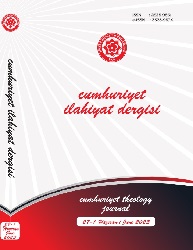Hadisteki İlleti Tespit ve Tenkit Prensibi Olarak “Filan Râvinin Rivâyetine Benzemiyor” İfadesi
The Statement in the Hadith as a Principle of Detection and Criticism: ‘It Doesn't Look Like The Reporter's Narration’
Author(s): Bahadır OpusSubject(s): Hermeneutics, Qur’anic studies
Published by: Cumhuriyet Üniversitesi İlahyat Fakültesi
Keywords: Hadith; Criticism; Hidden defect; Text; Taz'if;
Summary/Abstract: To determine the authenticity of the hadiths, some conditions were determined by the hadiths regarding the proof and text of the hadith. For a hadith to be categorised authentic, just and well-documented narrators and that the hadith should not be harmful or ill-informed. In these conditions, there are those that concern both the bill and the text, as well as those that concern the bill. The fact that the hadith is not illegitimate is among the conditions that concern both the chain and the text. There are some types and reasons for the hidden defect known as a hidden defect that harms the health of the hadith, and there are some methods used by the hadiths to determine the hidden defect. It is possible to divide these methods into two main headings. One of them is the method of reaching the cause of the hadith by making cem-i turk, and the other is the ability of the hadiths to reach the disease of the hadith with the ability they have acquired due to their preoccupation with hadiths. The cem-i turuk method, which is used in the detection of hidden defect, concerns a wider area of use, while the detection of hidden defect with the faculty of hadith concerns a more specific and relatively narrow field. For this reason, this ability possessed by the hadiths was likened to the jeweller's ability to distinguish between real gold and fake ones, and their inability to express the disease they detected with words was sometimes described as "inspiration" and "prophecy". One of the methods used by hadith scholars in determining hidden defect is the principle of criticism, "It does not resemble the narration of so-and-so". This principle of criticism is a method applied by hadith schools. Sometimes they used the expression "This hadith and so on and so does not resemble the narrator's narration", and sometimes they said that the hadith they criticize did not actually belong to the narrator. Ibn Rajab al-Hanbelī mentioned nineteen rules concerning the science of ilal in his work called Şerhu ʿileli't-Tirmidhī. Among these rules, there is also the principle of criticism "So-and-so does not resemble the narrator's narration". Ibn Rajab drew attention to this issue by calling it an "important rule" and emphasized that thanks to the fact that expert hadith memorizers are very familiar with the hadiths, they know the narrators together with their narrations and they know which hadith belongs to which narrator. Ahmed b. Hanbel used this criticism principle. He, Saīd b. Sinān's Enes b. Mālik, in the narrations he narrated from Abdulmelik b. Abī Ghaniyye→ Hakem b. Utayba→ Mujāhid→ Ibn Abbās. It has been seen that in a narration transmitted by, he applied the relevant criticism principle. In addition, it has been determined that this method of criticism is used in Ibn Abī Hātim's al-ʿilel. Velīd b. Jamil's narrations, Kāsim b. Abdirrahmān's criticism that it resembles narrations is an example of this. Ukaylī is also among those who use the criticism method, "it doesn't look like the narrator's narration". For example, Abdullah→ Abdullah b. Hayrān→ Şuʿbe→ Katāde→ Abu'l-Mutevekkil→ Abu'l- Mutavekkil's hadith about a narration conveyed as a source by the order of Abu Saîd al-Hudrī, " Katāde b. It is not one of Diāme's hadiths" and showed that he used the relevant criticism principle. Dārekutnī, one of the leading scholars of the legal field, is among those who apply this principle of criticism. Again, Süfyān as-Sevrī, Ali b. Medīnī, Cuzcānī and other scholars also applied this method. The criticism of "So-and-so does not resemble the narrator's narration" used by many of the hadith critics of the late period was criticized by Nasiruddin Albanī, one of the hadith scholars of the last period. After giving the rule that Ibn Rajab cites as an "important rule" in Silsiletu'l-ahādisi's-sahiha and which constitutes the subject of the research, it is right for Ibn Ammār al-Shahid to criticize the hadith that Muslim attributes to his Sahīh based on this rule not found. Based on Albani's narration in question, it is not appropriate to consider this rule invalid. Because of the absence of this hadith in the Muslim copies we have, it is highly probable that it means that he was aware of the hidden defect in the hadith and deduced the narration from his Sahih. On the other hand, the use of this rule by many muhaddis in the third and fourth centuries of the hijra, which is seen as the golden age of the sciences of narration, shows that the rule is an acceptable method of criticism by the experts of the field.
Journal: Cumhuriyet İlahiyat Dergisi
- Issue Year: 27/2023
- Issue No: 1
- Page Range: 297-309
- Page Count: 13
- Language: Turkish

